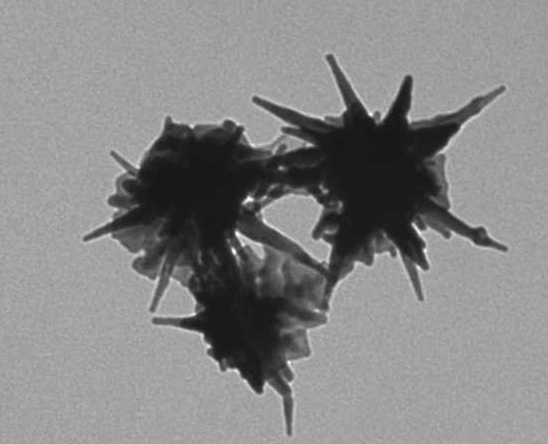All About Gold Nanostars
Definition, Properties and Applications
Gold nanostars are a type of anisotropic plasmonic gold nanomaterial with a star-shape morphology, featuring several nanoscale branches or protrusions extending from solid spherical nanoparticles (Meng et al., 2020). These multibranched nanoparticles exhibit interesting plasmonic properties, including tunable plasmon bands in the near-infrared (NIR) tissue optical window, making them suitable for in vivo imaging and therapeutic applications (Yuan et al., 2012). The unique plasmonic properties of gold nanostars are related to their highly branched nanostructures, which exhibit LSPR spectral features strongly dependent on the size (i.e., length and width) of the branches (Harder et al., 2020; Meng et al., 2016). Additionally, gold nanostars possess complex shapes and unique optical plasmon properties, making them suitable for applications such as sensing, surface-enhanced Raman scattering (SERS), catalysis, and photothermal therapy (Liu et al., 2014).
The synthesis and characterization of gold nanostars have been extensively studied, with research focusing on surfactant-free synthesis, 3D modeling, and two-photon photoluminescence imaging (Yuan et al., 2012). The size and morphology of gold nanostars can be tuned to optimize their sensing properties, and they have been successfully functionalized for enhanced intracellular delivery and efficient NIR photothermal therapy using ultralow irradiance (Yuan et al., 2012). Furthermore, the plasmonic properties of gold nanostars have been correlated with experiments, demonstrating their potential as promising plasmonic particles for ultrasensitive sensing (Shao et al., 2012).
Gold nanostars have been utilized in various biomedical applications, including as contrast agents for biological imaging, photothermal therapy, and computed tomographic (CT) imaging (Sasidharan et al., 2017). They have also been investigated for their biocompatibility and potential for use in cancer therapy, with studies demonstrating their enhanced photothermal activity and compatibility with cells and human blood (Zhu et al., 2018). Additionally, gold nanostars have been employed as surface-enhanced Raman scattering (SERS) labels for tissue diagnostics by immuno-SERS microscopy, highlighting their potential for biomedical imaging and spectroscopy applications (Schütz et al., 2011).
In conclusion, gold nanostars are versatile plasmonic nanomaterials with unique properties that make them suitable for a wide range of applications in bioanalysis, biomedical imaging, photothermal therapy, and ultrasensitive sensing. Their tunable plasmon bands, complex shapes, and biocompatibility make them promising candidates for further research and development in the field of nanomedicine.
Go here for Nanopartz Gold Nanostars.
References:
Harder, R., Wijenayaka, L., Phan, H., & Haes, A. (2020). Tuning gold nanostar morphology for the sers detection of uranyl. Journal of Raman Spectroscopy, 52(2), 497-505. https://doi.org/10.1002/jrs.5994
Liu, X., Wang, J., Liang, S., Yang, D., Nan, F., Ding, S., … & Wang, Q. (2014). Tuning plasmon resonance of gold nanostars for enhancements of nonlinear optical response and raman scattering. The Journal of Physical Chemistry C, 118(18), 9659-9664. https://doi.org/10.1021/jp500638u
Meng, X., Baride, A., & Jiang, C. (2016). Ligand controlled morphology evolution of active intermediates for the syntheses of gold nanostars. Langmuir, 32(26), 6674-6681. https://doi.org/10.1021/acs.langmuir.6b01592
Meng, X., Dyer, J., Huo, Y., & Jiang, C. (2020). Greater sers activity of ligand-stabilized gold nanostars with sharp branches. Langmuir, 36(13), 3558-3564. https://doi.org/10.1021/acs.langmuir.0c00079
Sasidharan, S., Bahadur, D., & Srivastava, R. (2017). Rapid, one-pot, protein-mediated green synthesis of gold nanostars for computed tomographic imaging and photothermal therapy of cancer. Acs Sustainable Chemistry & Engineering, 5(11), 10163-10175. https://doi.org/10.1021/acssuschemeng.7b02169
Schütz, M., Steinigeweg, D., Salehi, M., Kömpe, K., & Schlücker, S. (2011). Hydrophilically stabilized gold nanostars as sers labels for tissue imaging of the tumor suppressor p63 by immuno-sers microscopy. Chemical Communications, 47(14), 4216. https://doi.org/10.1039/c0cc05229a
Shao, L., Susha, A., Cheung, L., Sau, T., Rogach, A., & Wang, J. (2012). Plasmonic properties of single multispiked gold nanostars: correlating modeling with experiments. Langmuir, 28(24), 8979-8984. https://doi.org/10.1021/la2048097
Yuan, H., Fales, A., & Vo‐Dinh, T. (2012). Tat peptide-functionalized gold nanostars: enhanced intracellular delivery and efficient nir photothermal therapy using ultralow irradiance. Journal of the American Chemical Society, 134(28), 11358-11361. https://doi.org/10.1021/ja304180y
Yuan, H., Khoury, C., Hwang, H., Wilson, C., Grant, G., & Vo‐Dinh, T. (2012). Gold nanostars: surfactant-free synthesis, 3d modelling, and two-photon photoluminescence imaging. Nanotechnology, 23(7), 075102. https://doi.org/10.1088/0957-4484/23/7/075102
Zhu, Y., Sun, Q., Liu, Y., Ma, T., Su, L., Shi, X., … & Liang, F. (2018). Decorating gold nanostars with multiwalled carbon nanotubes for photothermal therapy. Royal Society Open Science, 5(8), 180159. https://doi.org/10.1098/rsos.180159

